 The Demand Generation Implementation Kit, the “I-Kit”, is a step-by-step guide to developing communication strategies to increase demand for nine priority commodities, and provides cross-cutting tools, guidance and adaptable commodity-specific content. By using the I-Kit, country teams can fast-track implementation of demand generation interventions in order to accelerate progress towards MDGs 4 and 5.
The Demand Generation Implementation Kit, the “I-Kit”, is a step-by-step guide to developing communication strategies to increase demand for nine priority commodities, and provides cross-cutting tools, guidance and adaptable commodity-specific content. By using the I-Kit, country teams can fast-track implementation of demand generation interventions in order to accelerate progress towards MDGs 4 and 5.
What is the objective of the I-Kit?
The primary objective of the I-Kit is to support country teams to develop commodity-specific messaging and activities, tailored to the country context and utilizing country-specific data.
For countries that already have RMNCH communication plans and programs, the I-Kit can be used as a tool to integrate strategic and effective components specifically for the underutilized commodities. In countries that still need to create RMNCH communication plans, the I-Kit offers guidance and support to develop evidence-based, effective demand generation strategies.
Who should use the I-Kit?
The I-Kit was designed to be useful to multiple audiences. The I-Kit will support the efforts of communication professionals working directly on behavior change communication programs as well as other professionals working in RMNCH who need to create a demand generation component to support program activities. Staff from ministries of health, non-governmental organizations and community-based organizations will all find useful resources, information and examples.
What is the Final Product?
Users of the I-Kit will develop demand generation strategies for selected health areas or commodities that are country or context specific and can be integrated into existing national communication strategies and interventions for RMNCH.
What commodities are covered in the I-Kit?
The I-Kit provides adaptable commodity-specific content, such as audience profiles, objectives, messaging and implementation activities, for nine priority commodities, organized by three overarching health areas along the RMNCH continuum of care:
- Contraceptive implants (for prevention of unintended pregnancy)
- Female condoms (for prevention of unintended pregnancy and STIs/HIV)
- Emergency contraception (for prevention of unintended pregnancy)
- Misoprostol (for postpartum hemorrhage)
- Magnesium sulfate (for pre-eclampsia/eclampsia)
- Chlorhexidine (for newborn cord care)
- ORS and zinc (for diarrhea)
- Amoxicillin (for childhood pneumonia)
How was the I-Kit developed?
The I-Kit was developed by the Health Communication Capacity Collaborative (HC3) at Johns Hopkins Bloomberg School of Public Health Center for Communication Programs (JHU·CCP), with support from the RMNCH Trust Fund and the United States Agency for International Development (USAID), in partnership with Demand Generation Technical Resource Team members, including Population Services International (PSI), International Consortium on Emergency Contraception (ICEC), PATH, Jhpiego and other partners.
Discussion Board on I-Kit
Join the I-Kit discussion group on Springboard for Health Communication, an online social network for social and behavior change communication professions. Designed to foster a community of practitioners working to increase demand for health commodities, it is a space to share experiences using the I-Kit, ask questions of other users, and to discuss the challenges and opportunities in developing demand generation communication strategies.
Photos
All photos on the site are courtesy of Photoshare, unless otherwise noted.
]]>The Demand Generation Implementation Kit (I-Kit) is organized by three overarching health areas across the RMNCH Continuum of Care and covers nine priority commodities:
- Contraceptive implants (for prevention of unintended pregnancy)
- Female condoms (for prevention of unintended pregnancy and STIs/HIV)
- Emergency contraception (for prevention of unintended pregnancy)
- Misoprostol (for postpartum hemorrhage)
- Magnesium sulfate (for pre-eclampsia/eclampsia)
- Chlorhexidine (for newborn cord care)
- ORS and zinc (for diarrhea)
- Amoxicillin (for childhood pneumonia)
Step-by-Step Guidance
Under each health area, there is an “overview” and six steps to work your way through:
- Step 1: Analyze the situation
- Step 2: Define a vision
- Step 3: Choose the target audiences
- Step 4: Select key messages
- Step 5: Determine activities and interventions
- Step 6: Plan for monitoring and evaluation
Each step provides guidance on how to complete that section of the communication strategy. Illustrative, adaptable content is also provided for each step at the bottom of the page. This can be viewed by step either as a preview (which does not require download) or downloaded in MS Word or PDF. A full version of each commodity strategy is also available under "core resources". The full strategy includes both guidance and illustrative content for the entire strategy.
The illustrative content is offered as examples, and is not designed as a “one-size-fits-all” model - every country and context is different, and the content of your strategy should be based on local research and data.
Core Resources
As noted above, the full version of the illustrative communication strategy for each commodity is provided under "core resources" on the right-hand side of the page.
Each section also offers additional cross-cutting tools developed specifically to support demand generation programs for the life-saving RMNCH commodities. These are listed under relevant steps and include:
This report reviews, assesses, and synthesizes the current evidence of social and behavioral drivers of demand generation for the 13 commodities as well as effective practices in implementing demand generation programs.
This tool provides guidance on how to conduct a country-based in-depth examination of the demand generation landscape for the life-saving commodities. The tool provides guidance in reviewing existing national evidence and identifying major evidence gaps and areas for additional analysis prior to launching a demand generation program.
This guide provides information and practical tools to help program managers determine how gender norms and roles may limit demand for the commodities and how to address these norms and roles to ultimately increase the demand for, and utilization of, RMNCH commodities.
This Framework provides step-by-step information and practical tools to guide media selection (i.e. communication channels) for demand generation activities using a theory-based approach. The Guide has a focus on ICT and new media channels as there is little guidance available around selection of these channels.
This resource provides an in-depth look at three programs that illustrate the use of Information and Communication Technologies (ICTs) and new media, specifically using mobile technologies, as part of an integrated strategy to increase demand for and use of RMNCH commodities and services.
This Guide is a resource for developing, implementing and assessing public-private partnerships (PPPs) to help increase demand for the life-saving commodities.
Additional Resources
Under each step of the health areas, additional useful resources are provided relevant to that step, including tools and examples of project materials from around the world.
Share your experiences using the I-Kit
How have you used the I-Kit to design communication strategies? Please share your experiences and the communications plans you have developed.
Are there new resources or topic areas that should be included in the toolkit? Please contact us to share your suggestions, comments, and questions.
]]>What is Demand Generation?
Demand generation increases awareness of and demand for health products or services among a particular intended audience through social and behavior change communication (SBCC) and social marketing techniques. Demand generation can occur in three ways:
- Creating new users - convincing members of the intended audience to adopt new behaviors, products or services;
- Increasing demand among existing users - convincing current users to increase or sustain the practice of the promoted behavior and/or to increase or sustain the use of promoted products and services;
- Taking market share from competing behaviors (e.g. convincing caregivers to seek health care immediately, instead of not seeking care until their health situation has severely deteriorated or has been compromised) and products or services (e.g. convincing caregivers to use oral rehydration solution (ORS) and zinc instead of other anti-diarrhea medicines).
Demand generation programs, when well-designed and implemented, can help countries reach the goal of increased utilization of the commodities by:
- Creating informed and voluntary demand for health commodities and services;
- Helping health care providers and clients interact with each other in an effective manner;
- Shifting social and cultural norms that can influence individual and collective behavior related to commodity uptake; and/or
- Encouraging correct and appropriate use of commodities by individuals and service providers alike.
In order to be most effective, demand generation efforts should be matched with efforts to improve logistics and expand services, increase access to commodities, and train and equip providers in order to meet increased demand for products and/or services. Without these simultaneous improvements, the intended audience may become discouraged and demand could then decrease. Therefore, it is highly advised to coordinate and collaborate with appropriate partners when forming demand generation communication strategies and programs.
Who are the Audiences of Demand Generation Programs for the 13 Life Saving Commodities?
Reducing maternal and child morbidity and mortality through increased demand for and use of RMNCH commodities depends on the collaboration of households, communities, and societies, including mothers, fathers and other family members, community and facility-based health workers, leaders, and policy makers. Some of the commodities are more provider-focused in terms of demand and utilization, but all depend on care-seeking by women and families.
Key Concepts and Definitions in Demand Generation
Social and Behavior Change Communication (SBCC)
Social Marketing
Mass and Traditional Media
Community Mobilization
Interpersonal Communication (IPC)
Entertainment Education
Information and Communication Technologies (ICTs)
Advocacy
Behavior Change Theories
Why is theory important to demand generation?
Increasing evidence suggests that demand generation interventions that are based on social and behavioral science theories are more effective than those without a theoretical base, especially when multiple theories and concepts are considered.[1] A strong theory can help design, implement and evaluate effective programs by providing an understanding of the influencing factors on behavior, the way in which behavior change occurs and potential entry points for behavior change interventions.
The key to using theory effectively is to identify one that seems to fit with the initial understanding of what currently influences behavior and social norms and to use that theory to explore in more detail the impetus for change.
A few of the theories and frameworks most often used in social and behavior change communication programming include:
Health Belief Model
Stages of Change
Theory of Reasoned Action/Theory of Planned Behavior
Social Learning/Social Cognitive Theory
Diffusion of Innovations
- Relative advantage – Does the new behavior offer any advantage over the current behavior?
- Compatibility – Is the new behavior compatible with current behaviors, beliefs, and values?
- Complexity – How difficult is the new behavior to perform?
- Trialability – Can it be tried without too much risk before making a decision?
- Observability – Are there opportunities to see what happens to others who adopt this behavior?
Ideation Model
Social Ecological Model
Extended Parallel Process Model (EPPM)
For more information on theories used for social and behavior change communication refer to the additional resources provided.
[1] Glanz, K. & Bishop, D. (2010) . The Role of Behavioral Science Theory in Development and Implementation of Public Health Interventions. Annual Review of Public Health, 30:399-418. doi: 10.1146/annurev.publhealth.012809.103604.
Reproductive Health |
||
 |
 |
 |
|
Female Condom
|
Contraceptive Implants
|
Emergency Contraception
|
|
Prevent HIV and unintended pregnancy
|
Prevent unintended pregnancy
|
Prevent unintended pregnancy
|
|
A female condom is a plastic pouch made of polyurethane that covers the cervix, the vagina, and part of the external genitals. Female condoms provide dual protection by preventing STI infection, including HIV, and unintended pregnancies.
|
Contraceptive implants are small, thin, flexible plastic rods that are inserted into a woman’s arm and release a progestin hormone into the body. These safe, highly effective, and quickly reversible contraceptives prevent pregnancy for 3‐5 years.
|
The emergency contraceptive pill (ECP) is the most widely available emergency contraceptive in developing countries. It is optimally taken in one dose of 1.5 mg as soon as possible after sexual activity. An alternative product of 0.75mg is also widely available.
|
| Learn More | ||
Maternal Health |
||
 |
 |
 |
|
Oxytocin
|
Misoprostol
|
Magnesium Sulfate
|
|
Post-partum hemorrhage
|
Post-partum hemorrhage
|
Eclampsia and severe
pre-eclampsia |
|
WHO recommends oxytocin as the uterotonic of choice for prevention and management of postpartum hemorrhage.
|
In settings where skilled birth attendants are not present and oxytocin is unavailable, misoprostol (600 micrograms orally) is recommended.
|
WHO recommends MgSO4 as the most effective treatment for women with eclampsia and severe pre-eclampsia.
|
| Learn More | ||
Child Health |
||
 |
 |
 |
|
Amoxicillin
|
Oral Rehydration Salts
|
Zinc
|
|
Pneumonia
|
Diarrhea
|
Diarrhea
|
|
Amoxicillin is an antibiotic that is used to treat pneumonia in children under five. Amoxicillin is prepared in 250mg scored, dispersible tablet (DT) in a blister pack of 10 DTs.
|
Oral Rehydration Salts (ORS) is a glucose‐electrolyte solution given orally to prevent dehydration from diarrhea. ORS is packaged in sachets of powder to be diluted in 200 ml, 500 ml or 1 liter of fluid, prepared to an appropriate flavor.
|
Replenishment with zinc can reduce the duration and severity of diarrheal episodes. Zinc is prepared either in 20 mg scored, taste masked, dispersible tablets or oral solutions at concentration of 10 mg/5ml.
|
| Learn More | ||
Newborn Health |
|||
 |
 |
 |
 |
|
Injectable Antibiotics
|
Antenatal Corticosteroids
|
Chlorhexidine
|
Resuscitation
|
|
Prevent newborn sepsis
|
Prevent Pre-term RDS
|
Prevent umbilical cord infection
|
Treat asphyxia
|
|
WHO recommends benzlypenicillin and gentamicin, in separate injections, as first-line therapy for presumptive treatment in newborns at risk of bacterial infection.
|
ANC are given to pregnant women who are at risk of preterm delivery to prevent respiratory distress syndrome in babies born in preterm labor.
|
Chlorhexidine digluconate is a low cost antiseptic for care of the umbilical cord stump that is effective against neonatal infections.
|
Birth asphyxia, or the failure of a newborn to start breathing after birth can be treated with resuscitation devices.
|
| Learn More | |||
<div id="searchbox"><div class="searchfacet">Type:
</div><div class="searchfacet">Topic: </div><div class="searchfacet">Commodity: </div><div class="searchfacet">Language: </div></div><div id="searchresults">
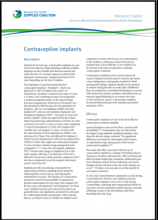
2013 Technical Brief on Contraceptive Implants
This document provides a brief history of implants and a description of their efficacy, side effects, and programmatic use.
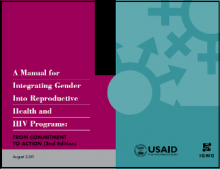
A Manual for Integrating Gender into Reproductive Health and HIV Programs: From Commitment to Action (2nd Edition)
This manual provides detailed instructions and tools for planning, developing, implementing and evaluating gender-sensitive programs for reproductive health and HIV (available in English, Spanish and French).

A Theory-Based Framework for Media Selection in Demand Generation Programs
This guide is a resource to help increase the demand for the 13 reproductive, maternal, newborn and child health (RMNCH) commodities identified as underutilized by the UN Commission on Life-Saving Commodities (UNCoLSC) for Women’s and Children’s Health. The guide provides step-by-step information and practical tools to guide media selection (i.e., communication channels) for demand generation activities using a theory-based approach. The guide has a focus on information and communication technology (ICT) and new media channels, as there is little current guidance available regarding the selection of these channels.

Adaptable Healthcare Provider Resources for ORS/Zinc
Adaptable Resources to assist efforts to promote the use of Zinc/ORS, including detail aids, posters, Q&A brochures, and videos.

Addressing the Role of Gender in the Demand for RMNCH Commodities: A Programming Guide
This guide is a resource for increasing demand for the 13 reproductive, maternal, newborn, and child health (RMNCH) commodities identified as underutilized by the UN Commission on Life-Saving Commodities (UNCoLSC) for Women’s and Children’s Health. This guide provides information and practical tools to help program managers determine how gender norms and roles may limit demand for these commodities, and how to address these norms and roles to ultimately increase the demand for and utilization of these commodities.

Advance Distribution of Misoprostol for Self-Administration: Expanding Coverage for Postpartum Hemorrhage Prevention
MCHIP’s updated program implementation guide provides step-by-step instructions on how to improve and expand misoprostol distribution programs alongside lessons from the field.
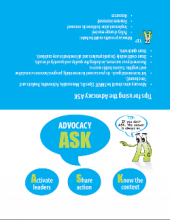
Advocacy ASK
Example for the ASK approach (activate leaders, share action, know the context).

Amoxicillin Project Examples
Click on the image to view project examples for Amoxicillin

An Adaptable Communication Strategy for Amoxicillin
An Adaptable Communication Strategy for Amoxicillin

An Adaptable Communication Strategy for Demand Generation: Chlorhexidine
This Adaptable Communication Strategy provides step-by-step guidance and illustrative content in creating a communication strategy to generate demand for chlorhexidine.

An Adaptable Communication Strategy for Demand Generation: Contraceptive Implants
This Adaptable Communication Strategy provides step-by-step guidance and illustrative content in creating a communication strategy to generate demand for contraceptive implants.

An Adaptable Communication Strategy for Demand Generation: Emergency Contraception
This Adaptable Communication Strategy provides step-by-step guidance and illustrative content in creating a communication strategy to generate demand for emergency contraception.

An Adaptable Communication Strategy for Demand Generation: Female Condom
This Adaptable Communication Strategy provides step-by-step guidance and illustrative content in creating a communication strategy to generate demand for female condom.

An Adaptable Communication Strategy for Demand Generation: Magnesium Sulfate
This Adaptable Communication Strategy provides step-by-step guidance and illustrative content in creating a communication strategy to generate demand for Magnesium Sulfate.

An Adaptable Communication Strategy for Demand Generation: Misoprostol
This Adaptable Communication Strategy provides step-by-step guidance and illustrative content in creating a communication strategy to generate demand for misoprostol.

An Adaptable Communication Strategy for Demand Generation: ORS/Zinc
This Adaptable Communication Strategy provides step-by-step guidance and illustrative content in creating a communication strategy to generate demand for ORS/Zinc.
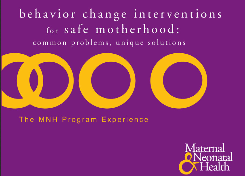
Behavior Change Interventions for Safe Motherhood: Common Problems, Unique Solutions
This paper focuses on the MNH Program’s work in the area of Behavior Change Interventions (BCI). BCI activities were undertaken in nearly every MNH Program country, and these activities were evaluated through population-based surveys in Burkina Faso, Guatemala, Indonesia and Nepal. The results of work in these four countries provide a valuable narrative from which constructive lessons can be learned. Behavior Change Interventions for Safe Motherhood Year Published: 2004 Organization: US Agency for International Development Length: 76 pages Languages: English
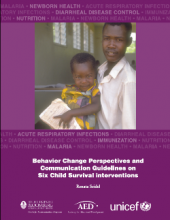
Behavior Change Perspectives and Communication Guidelines on Six Child Survival Interventions
This document is meant for those who want to incorporate behavior change and communication strategies into their child survival programs, as well as those who already plan and carry out such activities. It focuses on six major interventions and the key practices associated with these. It examines the challenges associated with improving these practices in developing country contexts, and aims to provide insight into how to design effective strategies. Behavior Change Perspectives and Communication Guidelines Year of Publication: 2005 Organization: Johns Hopkins Center for Communication Programs, Academy for Educational Development, UNICEF Length: 294 pages Languages: English
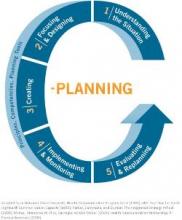
C-Modules: A Learning Package for Social Behavior Change Communication
C-Modules is a training program developed by Communication for Change (C-Change) to be used for facilitated, face-to-face workshops on social and behavior change communication. The modules cover situational analysis, program design and development, implementation, monitoring, evaluation, and re-planning. C-Modules: A Learning Package for Social Behavior Change Communication Year of Publication: 2011 Organization: FHI360/C-Change Length: 5 modules Languages: English, French, Spanish, Portuguese

Chlorhexidine Project Examples
Click on the image to view project examples for Chlorhexidine
</div> ]]>
Email: info@healthcommcapacity.org
]]>